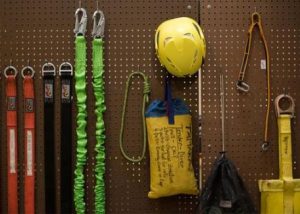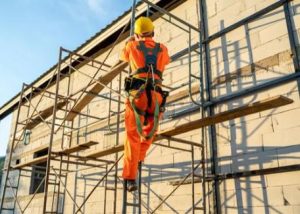By Ed Kauffman, Safety Training Manager
According to the current statistics from the Centers for Disease Control and Prevention and the National Institute for Occupational Safety and Health, falls were the leading cause of death in the United States’ construction industry for 2020. Sadly, approximately 300 to 400 construction workers fell to their deaths each year. This is a tragic reflection of why falls are consistently one of the Occupational Safety and Health Administration’s (OSHA) Focus Four, or Fatal Four, hazards.
 Based on the most recent data for Fiscal Year 2021 (October 1, 2020-September 30, 2021), falls are one of the most frequently cited standards following worksite inspections by OSHA compliance safety and health officers. Moreover, it’s important to realize fall-related hazards appear four times in the top six most frequently cited OSHA standards resulting in penalties: fall protection; ladders; scaffolding; and fall protection training. Let’s look at what employees and employers need to do to comply and reduce the number of fall fatalities.
Based on the most recent data for Fiscal Year 2021 (October 1, 2020-September 30, 2021), falls are one of the most frequently cited standards following worksite inspections by OSHA compliance safety and health officers. Moreover, it’s important to realize fall-related hazards appear four times in the top six most frequently cited OSHA standards resulting in penalties: fall protection; ladders; scaffolding; and fall protection training. Let’s look at what employees and employers need to do to comply and reduce the number of fall fatalities.
Fall Protection
In the fall protection for construction regulations, OSHA identifies an employer’s responsibilities as follows.
- Assessing the workplace to determine if walking/working surfaces are sufficient to safely support workers and their associated work-related activities.
- Determining if fall protection is necessary to sufficiently protect employees from fall hazards based on requirements set forth by the OSHA standard.
- Selecting and providing employees with compliant fall protection systems that meet all applicable OSHA standards.
The Six-Foot Rule
OSHA states that fall protection systems must be in place and used when construction workers are working at heights of 6 feet or more above a lower level. Furthermore, this rule applies to heights of less than 6 feet when employees are required to work near, at, or with significant, serious hazards and/or dangerous equipment.
Ladders
OSHA has outlined and updated specific requirements for three basic types of ladders commonly used in construction.
- Extension ladders – These ladders typically comprise two sections that contain brackets or guides.
- Job-made wooden ladders – These are wooden ladders constructed at, or on, construction sites.
- Stepladders – These are any self-supporting A-frame ladders used on construction sites.
Requirements for the distinct types of ladders vary by function and ladder structure. It is highly recommended that each ladder type on a site is compared to the correct portion of the standard. This will help to ensure on-site ladders are OSHA compliant and used according to the standard.
Scaffolding
OSHA defines scaffolds as an elevated, temporary work platform and identifies two distinct types:

- Supported scaffold – Built from the ground up, this type of scaffolding consists of one or more platforms on rigid, load-bearing support. Other equipment, such as scissor and aerial lifts, can be considered part of this group.
- Suspended scaffold – At least one or more platforms are suspended by non-rigid, overhead support, such as rope.
Each type of scaffolding has specific OSHA requirements, so it is vital not only to review the OSHA standard and relevant letters of interpretation, but also to ensure the contracted responsible on-site party is erecting, utilizing, and designing compliant scaffolding.
Fall Protection Training
For the regulations pertaining to fall protection training in the construction industry, OSHA outlines an employer’s responsibilities. These include:
- An employer must develop and utilize a fall protection training program for each employee who might be exposed to fall hazards. This management-approved program must include fall hazard recognition and how to minimize these hazards.
- Each employee must be successfully trained, as needed, by a competent person who is qualified in the specific areas identified for fall protection safety training and procedures.
- For each employee, an employer must maintain written certification records that meet specific OSHA requirements.
- Fall protection training must include the correct procedures for all fall protection systems in use, including personal fall arrest systems.
Not sure if your company needs fall protection training? RETTEW offers a variety of courses and services to ensure organizations and businesses are prepared, including OSHA’s Construction Outreach 10- and 30-hour courses. Contact our Safety Training Manager, Ed Kauffman, to learn more about RETTEW’s comprehensive and compliant safety training programs and custom training curriculums.
Additional Offerings
Safety training and consulting are only some of RETTEW’s 600-plus services. Our safety team works hand in hand with engineers, scientists, project managers, and other technical experts at places such as manufacturing facilities, drill pads, and commercial construction sites. We are well respected for our work in a diverse number of industries and are known for ensuring workers and equipment remain safe, which keeps your projects on track and your bottom line growing.

